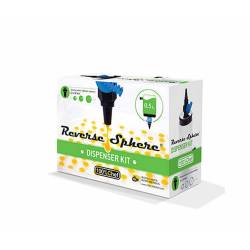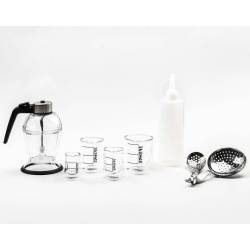So much has been said about alcoholic and nonalcoholic spherification, but there still seems to be a lot of confusion about its methods of use and implementation, so let's try to clarify.
MOLECULAR SPHERIFICATION: WHEN DID IT ORIGINATE?
Spherification is a technique of molecular cuisine first realized by Albert and Ferran Adrià, Spanish chefs and pioneers of a new era in cooking.
First translated to the restaurant where Ferran was head chef, El Bulli in Girona, and then around the world, the brothers paved the way for those who wanted to experiment with making new recipes for food spherification, both in form and texture. One example among many of spherification in the kitchen is that of Heston Blumenthal, head chef at Fat Duck in England's Berkshire.
Cocktail spherification, or molecular spherification, was later introduced into the world of mixing as well. In Italy it was deepened and made known by Dario Comini, patron of the Nottingham Forest in Milan and king of cocktail spherification, or even more precisely, molecular cocktail spherification. How to make molecular cocktails? Turn to the king of spherified cocktails!
>>> Also check out the Sphere Chef 100% Chef kit.
WHAT IT IS.
Nothing less than the controlled gelling of a liquid that solidifies when immersed in a specific bath, forming spheres of different sizes.
MOLECULAR COOKING SPHERIFICATION: DIFFERENT TYPES
As far as molecular cooking is concerned, spherification, both basic and reverse, allows for malleable and manipulable spheres.
BASIC SPHERIFICATION
Culinary art and chemistry, same flavors but different textures.
Basic spherification necessarily needs Algin, a gelling agent that determines its flexibility.
In short, sodium alginate must be combined with the mixture you want to spherify and then poured into the calcic bath (Calcic). A syringe without a needle or hemispherical molds can be used to pour it.
What does the chemical process consist of?
Calcium penetrates the preparation and forms a gel with the sodium alginate contained in it.
What do you get?
A sphere with a liquid heart, unstable over time.
REVERSE SPHERIFICATION
Unlike basic spherification, reverse spherification is achieved by the presence of the calcium necessary for gelling already in the preparation you want to make into spheres.
It is necessary to properly mix and rest the food to be spherified to make the bubbles disappear and then immerse it in the sodium alginate bath, just as in basic spherification, for a top'home chef alginate' effect.
Please note
If the ingredient you choose is too acidic, the result will not be satisfactory.
If it is excessively liquid, it will not turn into a perfect sphere.
How long does it take for the process to be complete?
It only takes 3 minutes.
However, if the spheres remain in the alginate bath for a long time, the gel will be thicker so it is necessary to control the soaking time.
In addition, it is important to rotate the spheres in the bath to achieve homogeneous alginate gelation in cooking and especially to prevent them from touching each other so that they do not stick together.
Finally, it is necessary to rinse the spheres well to achieve a smooth surface without imperfections.
Differences between basic and reverse spherification
In reverse spherification, washing the spherification process stops the spherification process immediately.
Basic spherification produces results that must be consumed in a short time because of their instability, while reverse spherification is long-lasting and stable over time.
The reverse process is especially good for products rich in calcium and alcohol and allows spherification of almost any ingredient.


